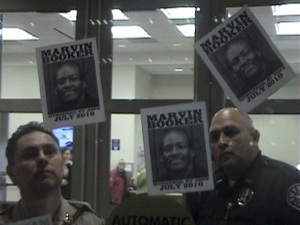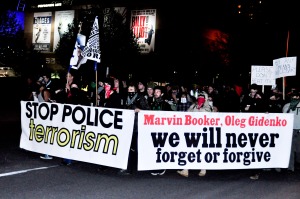Denver police lose in court again! Amelia Nicol’s final charges dismissed!
DA admits fear of losing at trial
 It’s been a long 5 months for Amelia Nicol, a 21 year old woman from Colorado who became infamous across the region after gracing the front pages of news websites and blogs. Amelia was accused of throwing a molotov cocktail at local police (some media sites even claimed it was a pipe bomb) during the aftermath of a demonstration against Denver police on May 6th. Amelia was arrested and charged with 2 counts of attempted murder of a law enforcement officer in the first degree, one count of use of explosives, one count of possession of explosives, one count of second-degree arson, one count of criminal mischief, one count of inciting a riot, two counts of attemped third-degree assault, and one count of resisting arrest.
It’s been a long 5 months for Amelia Nicol, a 21 year old woman from Colorado who became infamous across the region after gracing the front pages of news websites and blogs. Amelia was accused of throwing a molotov cocktail at local police (some media sites even claimed it was a pipe bomb) during the aftermath of a demonstration against Denver police on May 6th. Amelia was arrested and charged with 2 counts of attempted murder of a law enforcement officer in the first degree, one count of use of explosives, one count of possession of explosives, one count of second-degree arson, one count of criminal mischief, one count of inciting a riot, two counts of attemped third-degree assault, and one count of resisting arrest.
These seven felony and three misdemeanor charges threatened to send Amelia to prison for over 100 years. A woman who turned 21 inside a jail cell over Memorial Day Weekend faced the rest of her life in prison.
 Amelia’s arrest must be placed into a greater context of a social struggle against the police that has been growing and developing in Denver over the past year and a half. In July 2010, Marvin Booker, a homeless street preacher, was murdered by Denver County Sheriff’s Deputies while he was held prisoner inside the Van Cise-Simonett Detention Center in downtown Denver. Marvin, refusing to be separated from his shoes, valued among the few possessions he owned, was tazed, beaten, placed into chokeholds, kicked, and punched by five deputies. He died after they placed him face down into a jail cell. Other prisoners had to notify the deputies that he had stopped breathing.
Amelia’s arrest must be placed into a greater context of a social struggle against the police that has been growing and developing in Denver over the past year and a half. In July 2010, Marvin Booker, a homeless street preacher, was murdered by Denver County Sheriff’s Deputies while he was held prisoner inside the Van Cise-Simonett Detention Center in downtown Denver. Marvin, refusing to be separated from his shoes, valued among the few possessions he owned, was tazed, beaten, placed into chokeholds, kicked, and punched by five deputies. He died after they placed him face down into a jail cell. Other prisoners had to notify the deputies that he had stopped breathing.
In those hot summer days, more allegations of police abuse and misconduct started to make the front pages of the local papers. Law enforcement officers from local departments were accused in a seemingly endless list of allegations of beatings, attacks, sexual assaults, kidnappings, possession and manufacture of child pornography, DUIs, and more. The local agencies seemed out of control, and few people within the “legitimate” power structures were willing to step up to address these issues.
Outraged residents started to organize and mobilize. Protests and marches were held. One of the first unpermitted street marches since the DNC was organized by West Denver Copwatch, and over 150 people hit the streets of downtown, tracing a path from various locations of police terror and abuse.
A meeting of leaders and organizers from various non-profits and institutional Left organizations confronted the Safety Manager, and he soon resigned.
 There was a fire in the air at the end of the Summer, and by the annual October 22nd Day Against Police Brutality, the anger could easily be felt in the air. A march was called for by local anarchists, and nearly a hundred militant youth filled the 16th Street Mall, attacking a police car and shutting down nighttime traffic in the commercial center of Denver. Despite the attacks on the police cruiser and the second successful unpermitted street march, no arrests were made.
There was a fire in the air at the end of the Summer, and by the annual October 22nd Day Against Police Brutality, the anger could easily be felt in the air. A march was called for by local anarchists, and nearly a hundred militant youth filled the 16th Street Mall, attacking a police car and shutting down nighttime traffic in the commercial center of Denver. Despite the attacks on the police cruiser and the second successful unpermitted street march, no arrests were made.
The energy of the Summer and Fall was squashed briefly by the cold Colorado winter. But by January, when even more cases of police terrorism filled local tabloids, the fire of the anger could not be cooled. A demonstration called for January 29th saw more than 300 people run riot through the streets of downtown, with nearly everything not bolted down becoming a street barricade or a projectile. Hundreds of  stickers decrying the police were put up all over the area, and anti-cop graffiti covered the yuppie shopping establishments. Despite the widespread property destruction, only one person was arrested. They would be released within hours without any charges filed against them.
stickers decrying the police were put up all over the area, and anti-cop graffiti covered the yuppie shopping establishments. Despite the widespread property destruction, only one person was arrested. They would be released within hours without any charges filed against them.
A long pause in street demonstrations made room for some clandestine actions, with several attacks on local police targets in the late winter and early spring. A forum was also organized, which saw dozens of people attend to help strategize for the future of the anti-police movement.
 By May, another unarmed person had been gunned down by a local police department, executed while sitting in his truck in an industrial park in Aurora. It was time for the movement to hit the streets yet again. On May 9th, 100 folks took over the Santa Fe Art District and then proceeded to march through the downtown corridor, erecting street barricades, shutting down traffic, and redecorating the city.
By May, another unarmed person had been gunned down by a local police department, executed while sitting in his truck in an industrial park in Aurora. It was time for the movement to hit the streets yet again. On May 9th, 100 folks took over the Santa Fe Art District and then proceeded to march through the downtown corridor, erecting street barricades, shutting down traffic, and redecorating the city.
A short scuffle occurred when police refused to allow the crowd back into the Santa Fe District, and the march attempted to disperse a short while later. Within the dispersal, a small firework went off, and the police chased a young woman, later to be identified as Amelia Nicol, down a nearby alley where she would be assaulted and arrested.
Amelia’s arrest and the subsequent charges illustrated an effort on the part of local police to attack the militant elements of the growing anti-police terror movement. Amelia would become a symbol. To the police, she would symbolize what would happen to those who resisted their reign of terror. To the militants, she would symbolize the very nature of the struggle they were engaged in. This was war. The police were treating it as such. It was far past time for those on the other side to treat it the same way.
The Denver Anarchist Black Cross, a local organization that provides movement defense support, sprang into action to work to defend Amelia. A press conference was organized in front of the DA’s office, and hundreds of postcards demanding her charges be dropped were delivered to the Assistant District Attorney.
Amelia spent 38 days in jail, until a judge dismissed the most serious of the charges during a preliminary hearing on June 9th. Several days later, members of Denver Anarchist Black Cross provided the necessary bail for Amelia, and she was out amongst comrades. She was given a place to live, a job, clothing, and as much support as the local movement could muster as she and Denver ABC dug in for what was expected to be a long and drawn out legal battle. Amelia had already spent more time in jail than any members of any local law enforcement agency who had been implicated in violent attacks against community members. And she still faced over a dozen years in prison if found guilty of the remaining charges.
 On July 9th, the Denver community marked the one year anniversary of the murder of Marvin Booker. A street march was held, and the crowd of 150 again shut down the 16th Street Mall, as the march worked its way to the Van Cise-Simonet Detention Center to join a rally organized by the ACLU. Halfway along the march route, police attacked the crowd as they attempted to arrest a participant. A short street brawl erupted. When it was over, several police officers had bloodied faces, and three comrades were in custody. It cannot be stressed enough that many more would have been arrested if comrades hadn’t fought back and forced the unarrest of several participants. The march then continued to the rally, unimpeded after the scuffle.
On July 9th, the Denver community marked the one year anniversary of the murder of Marvin Booker. A street march was held, and the crowd of 150 again shut down the 16th Street Mall, as the march worked its way to the Van Cise-Simonet Detention Center to join a rally organized by the ACLU. Halfway along the march route, police attacked the crowd as they attempted to arrest a participant. A short street brawl erupted. When it was over, several police officers had bloodied faces, and three comrades were in custody. It cannot be stressed enough that many more would have been arrested if comrades hadn’t fought back and forced the unarrest of several participants. The march then continued to the rally, unimpeded after the scuffle.
Obviously, the police had upped the ante yet again. The arrest and subsequent charging of Amelia had not done enough to cow the movement into inaction. They would need to continue to escalate their tactics against the militants.
However, all of the arrestees were charged with minor offenses. One, a minor, had their charges completely deferred within days. Two still face charges, but will go to trial in October, unwilling to negotiate with the state and accept any plea deal.
It was this same attitude that was present on September 14th when Amelia was offered a last minute plea deal from the District Attorney. If she pleaded guilty to possession of a deadly weapon, the remaining charges of possession of an explosive, assault on a law enforcement officer, and resisting arrest would be dropped. Amelia rightfully refused such an offer. It would only have added credibility to the state’s attack on her in the first place.
So it was that during the afternoon of September 15th, Amelia made her scheduled appearance at her discovery hearing to hear all the evidence the state had against her and to make any motions for dismissal of said evidence. However, a hearing was not to be had. The District Attorney approached the podium only to state that she had filed a motion for dismissal. The DA stated that she feared that the State did not have enough evidence to win at trial. Amelia’s battle was over. She had won. The state had backed down and caved.
Amelia went from facing over 100 years in prison to having every single charge against her dismissed. She spent 38 days in jail as a political prisoner because she refused to pay the state’s initially bloated bond, and refused to play its game. She won, in the end, because she continued to fight the state at every level. Her no-compromise attitude prevailed. No matter how hard the state tried to intimidate her, she never relented. And in the end, it was this attitude and strategy that won out.
We still have two comrades facing charges. But they too will face down the state. Though the consequences for them are minor when compared to what Amelia faced, they too have made it clear that they understand what’s at stake. With every court date that our comrades must attend, our entire movement is on trial.
Stay tuned to the DABC blog at denverabc.wordpress.com for updates and calls to action for our two comrades (Jesse Cooper and Matt Funk) still facing charges. For now, please make yourself available to pack the courtroom for their joint trial on October 12th.
In love and solidarity,
DABC Crew



No comments:
Post a Comment